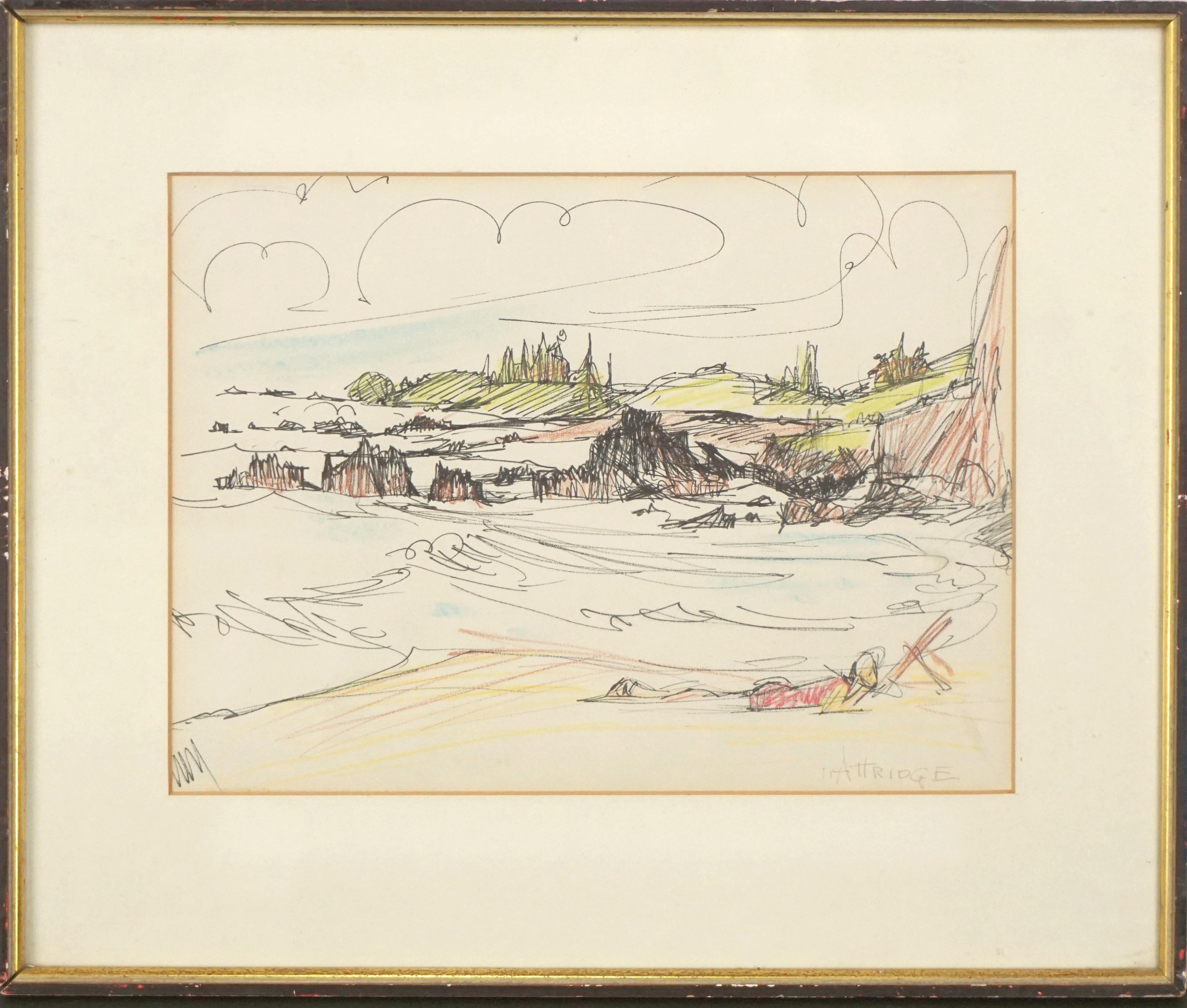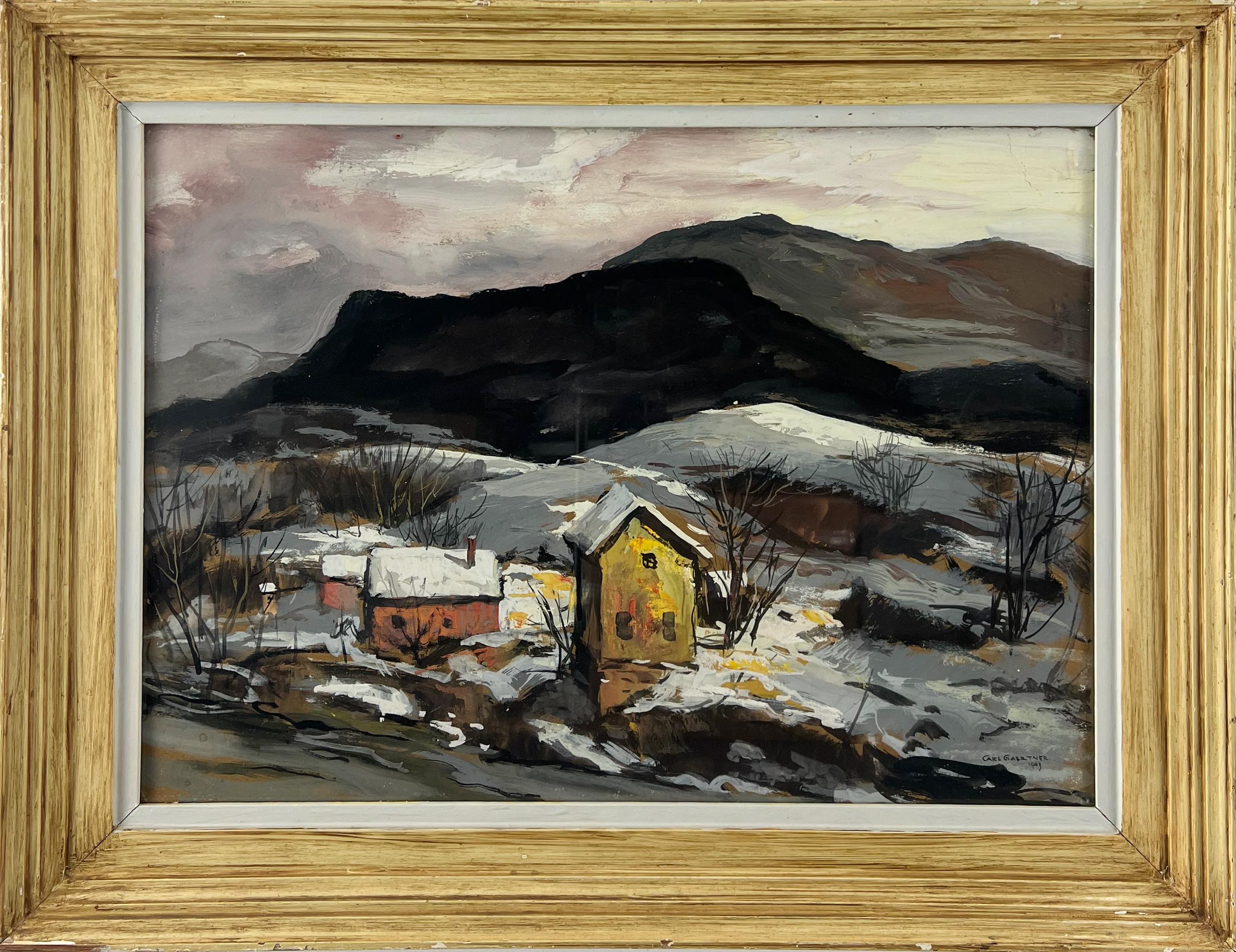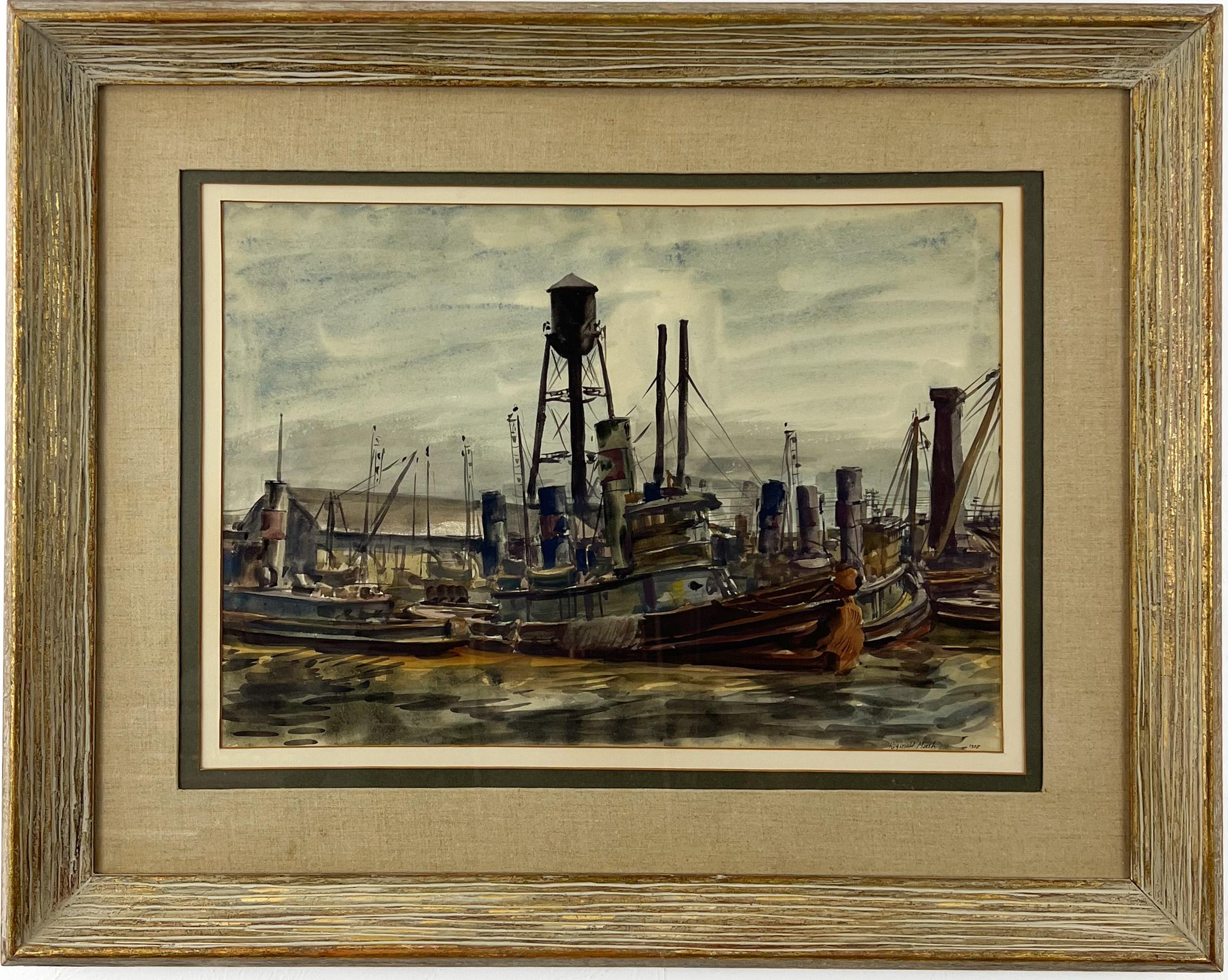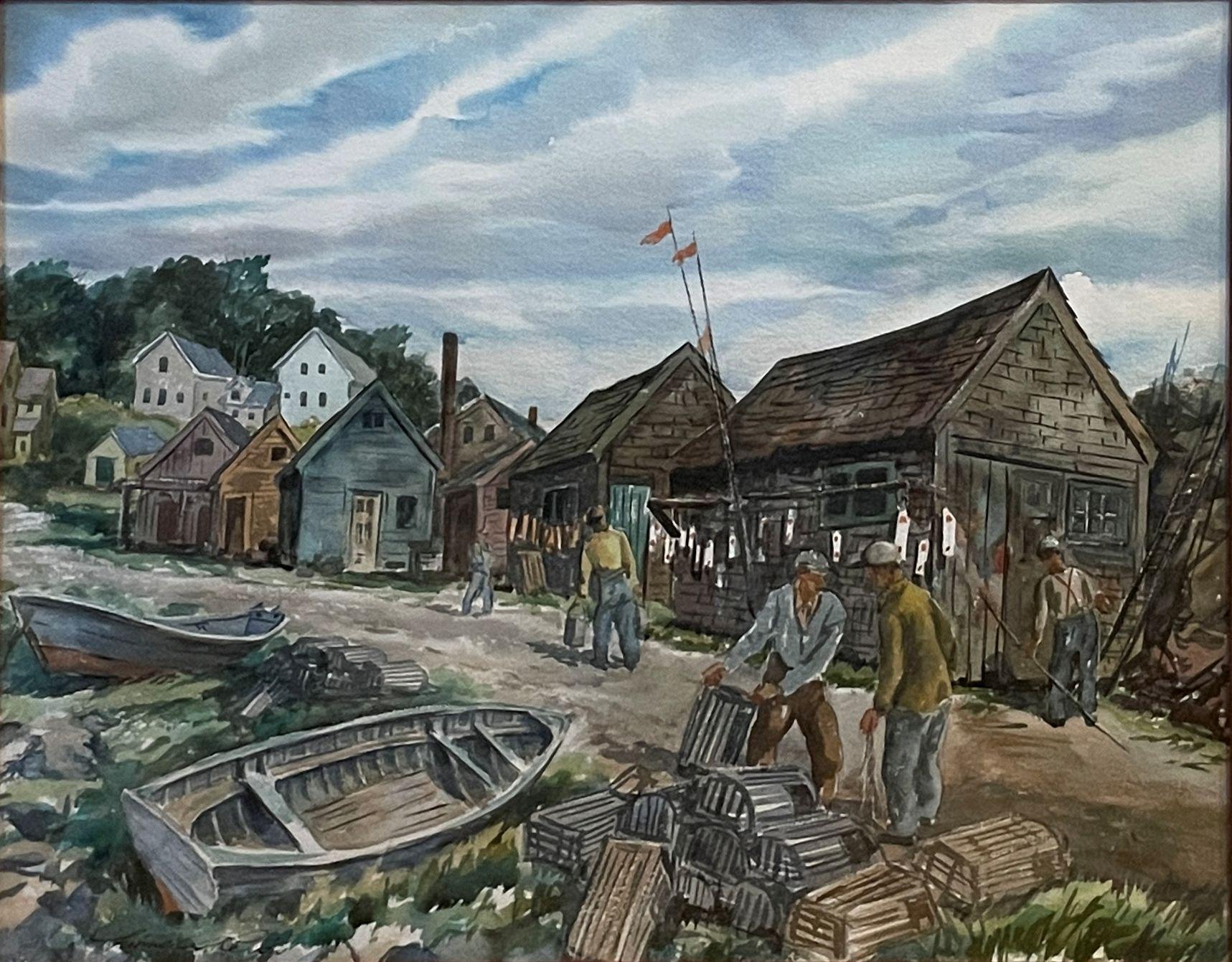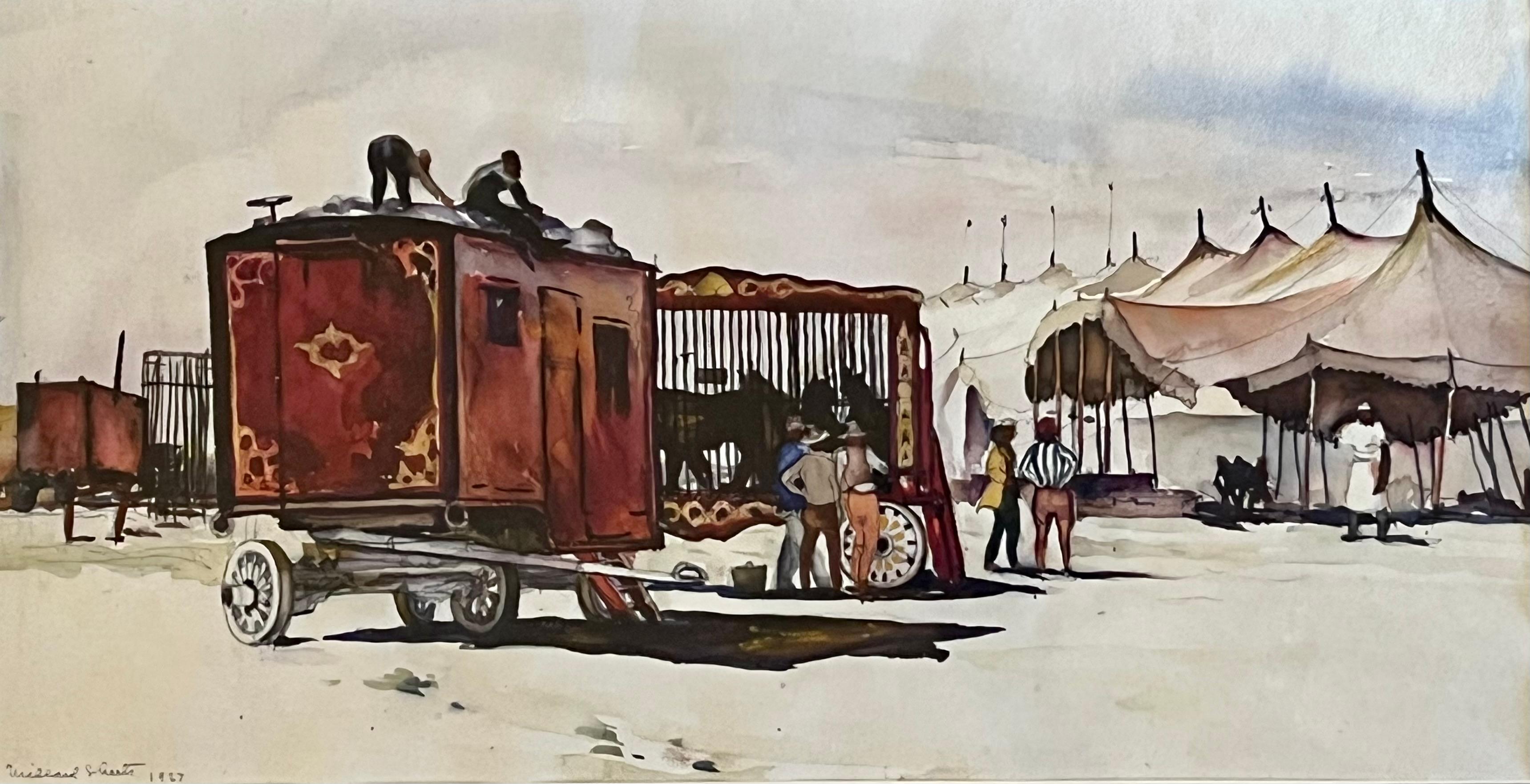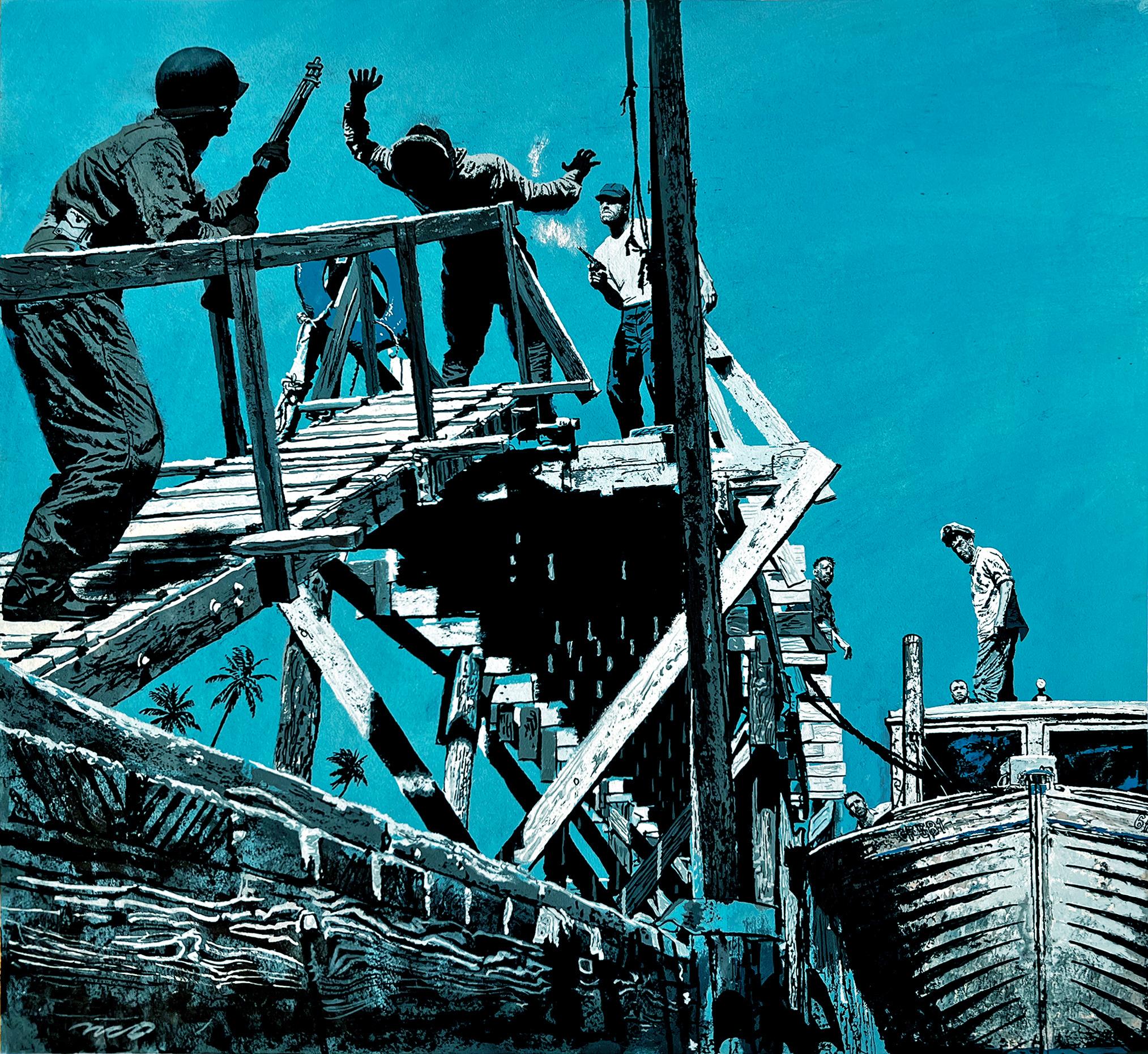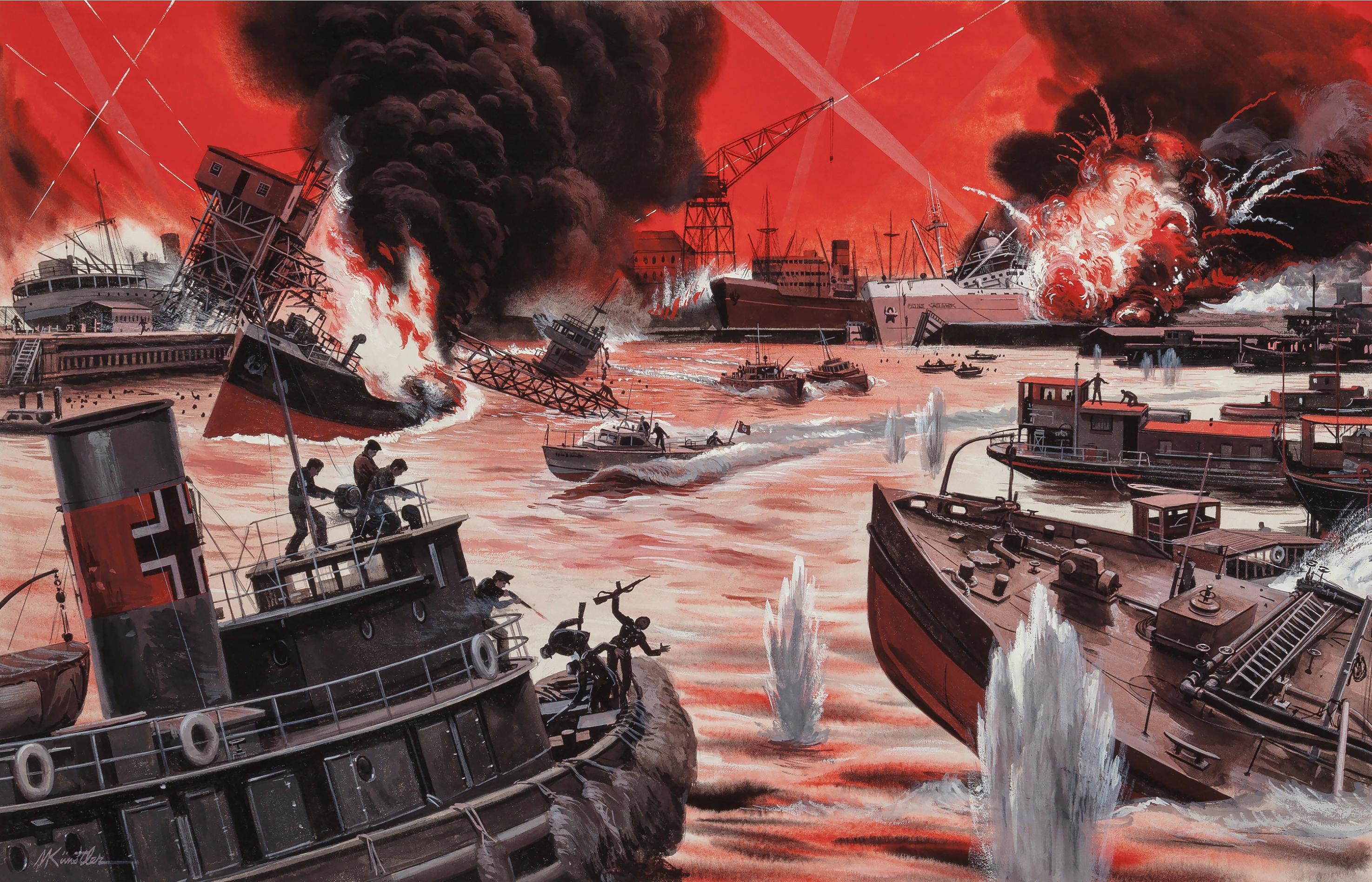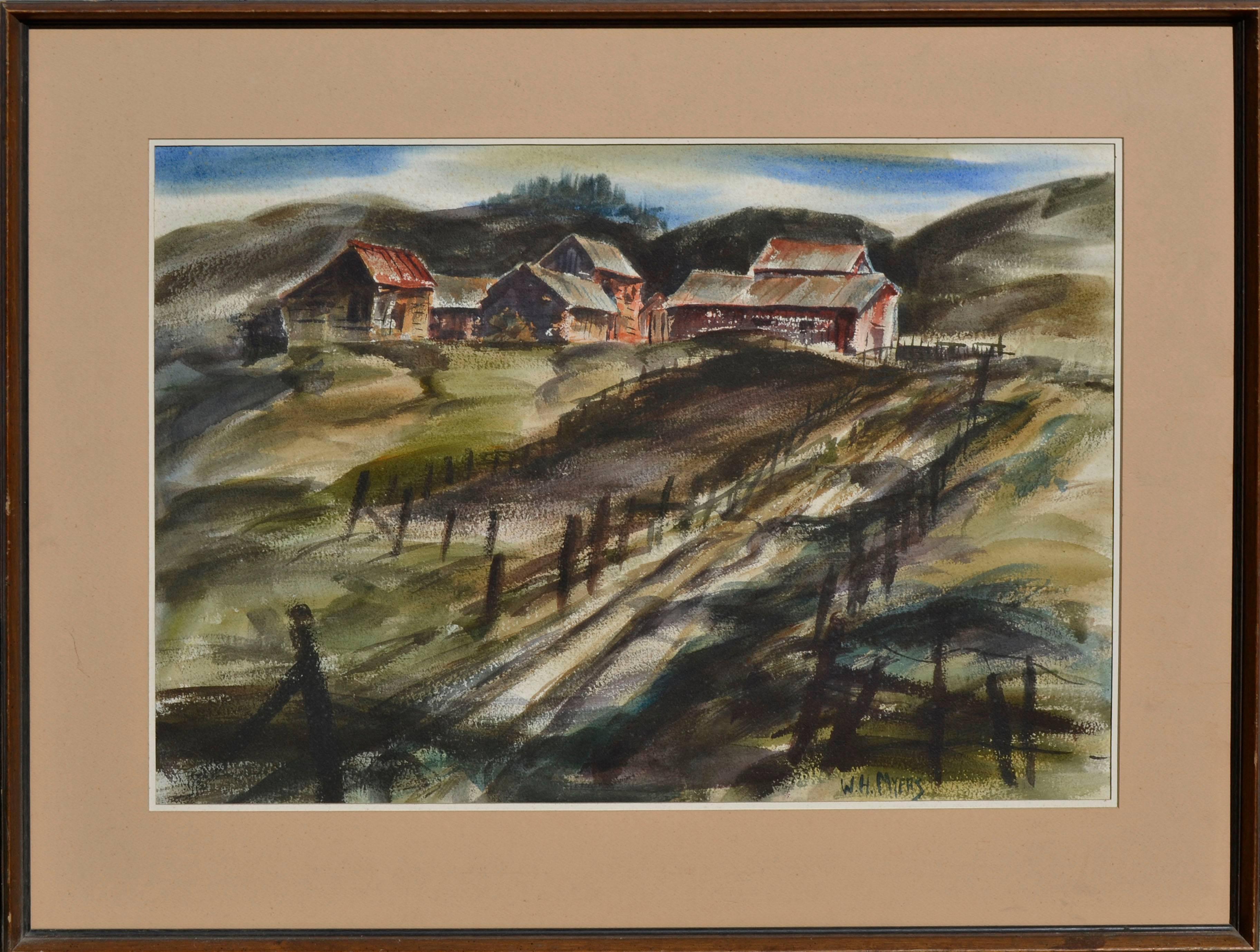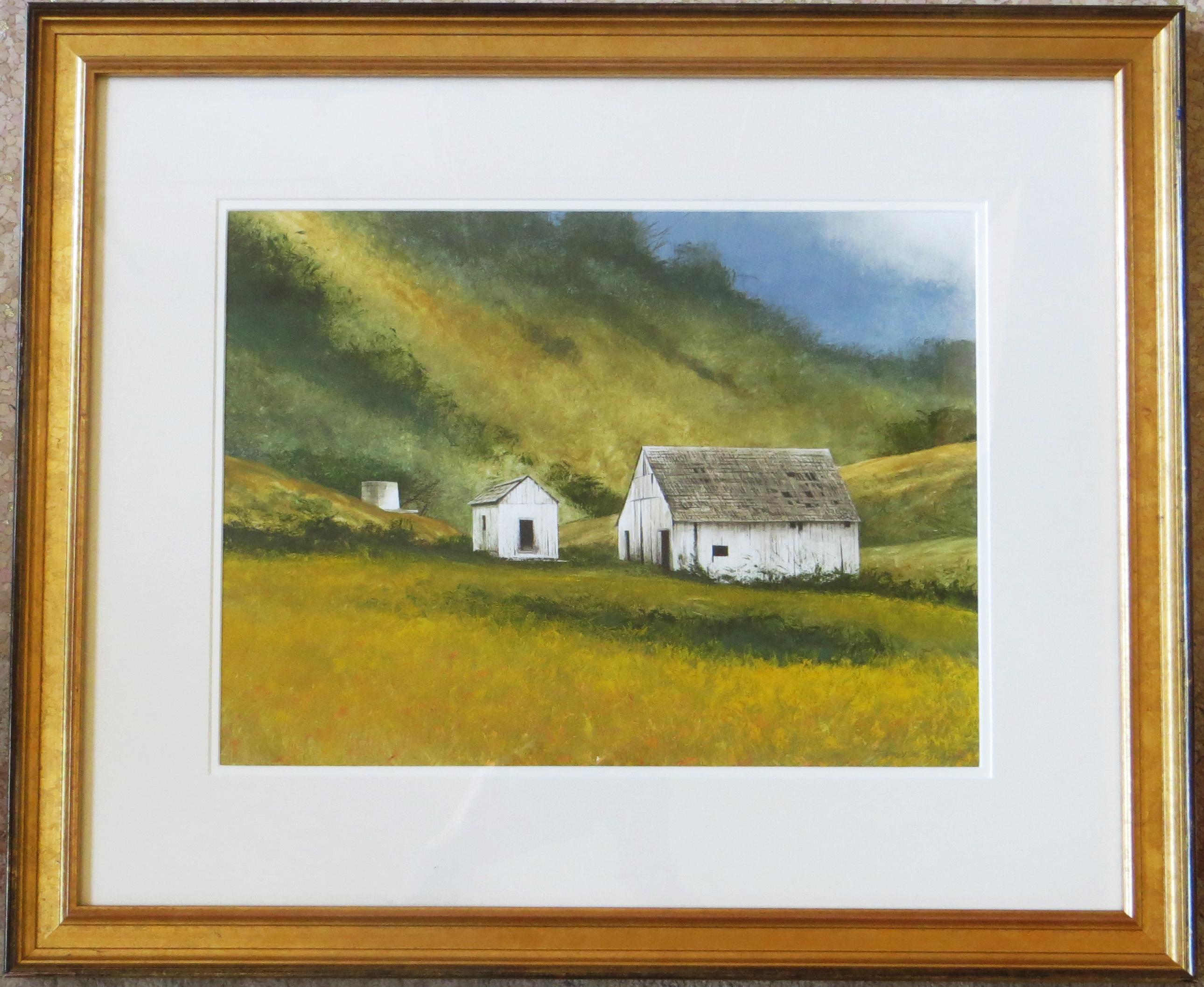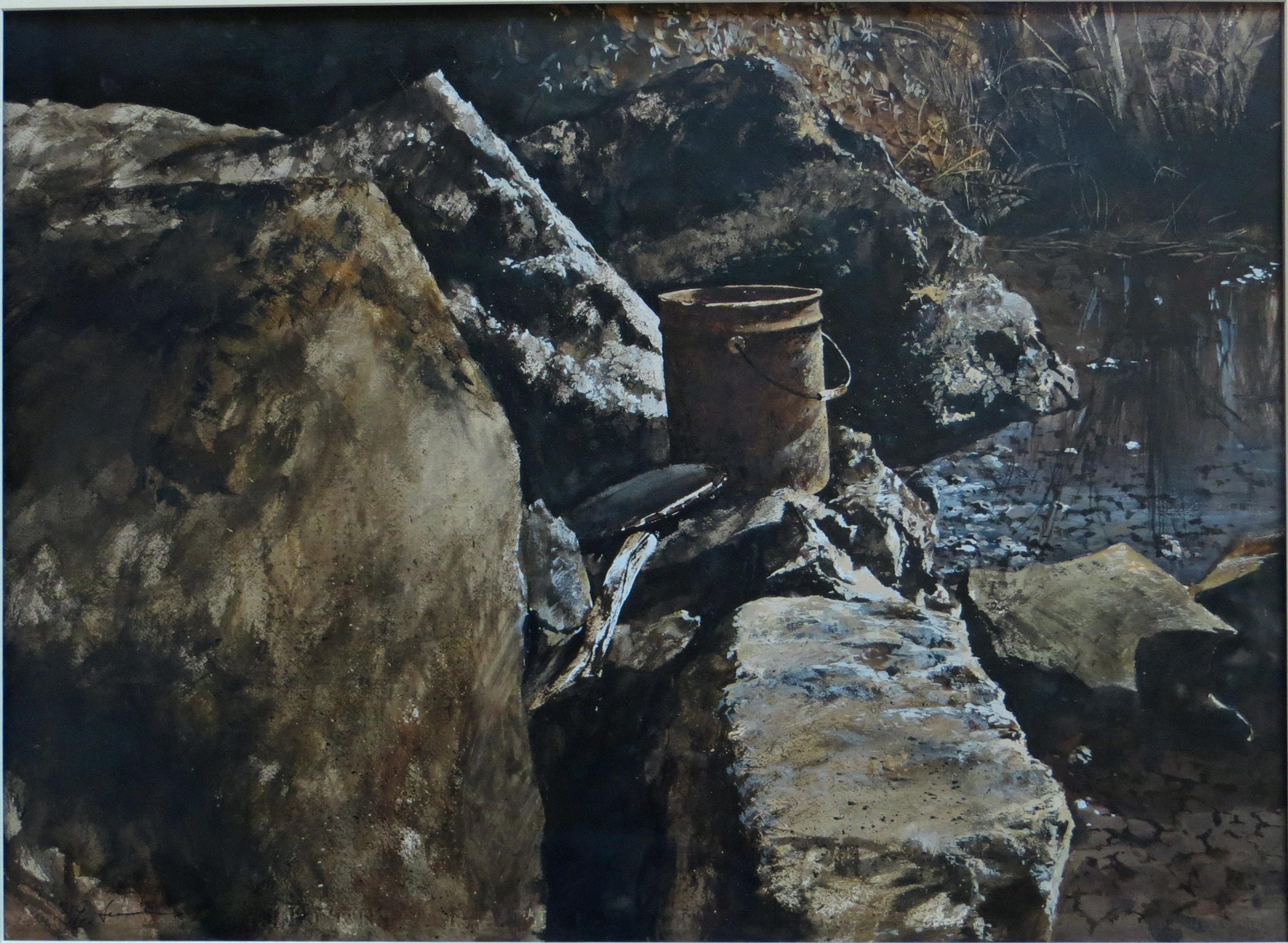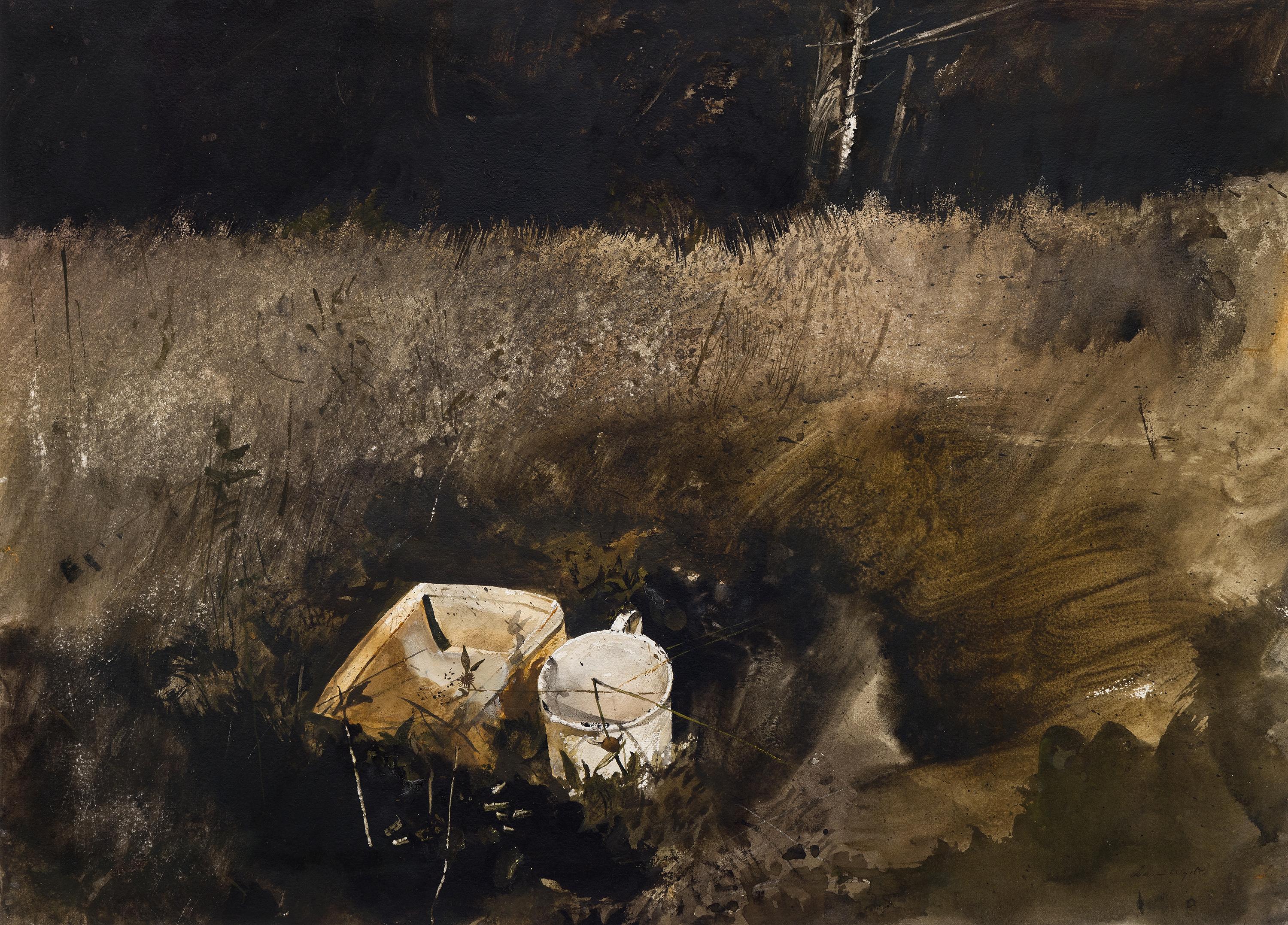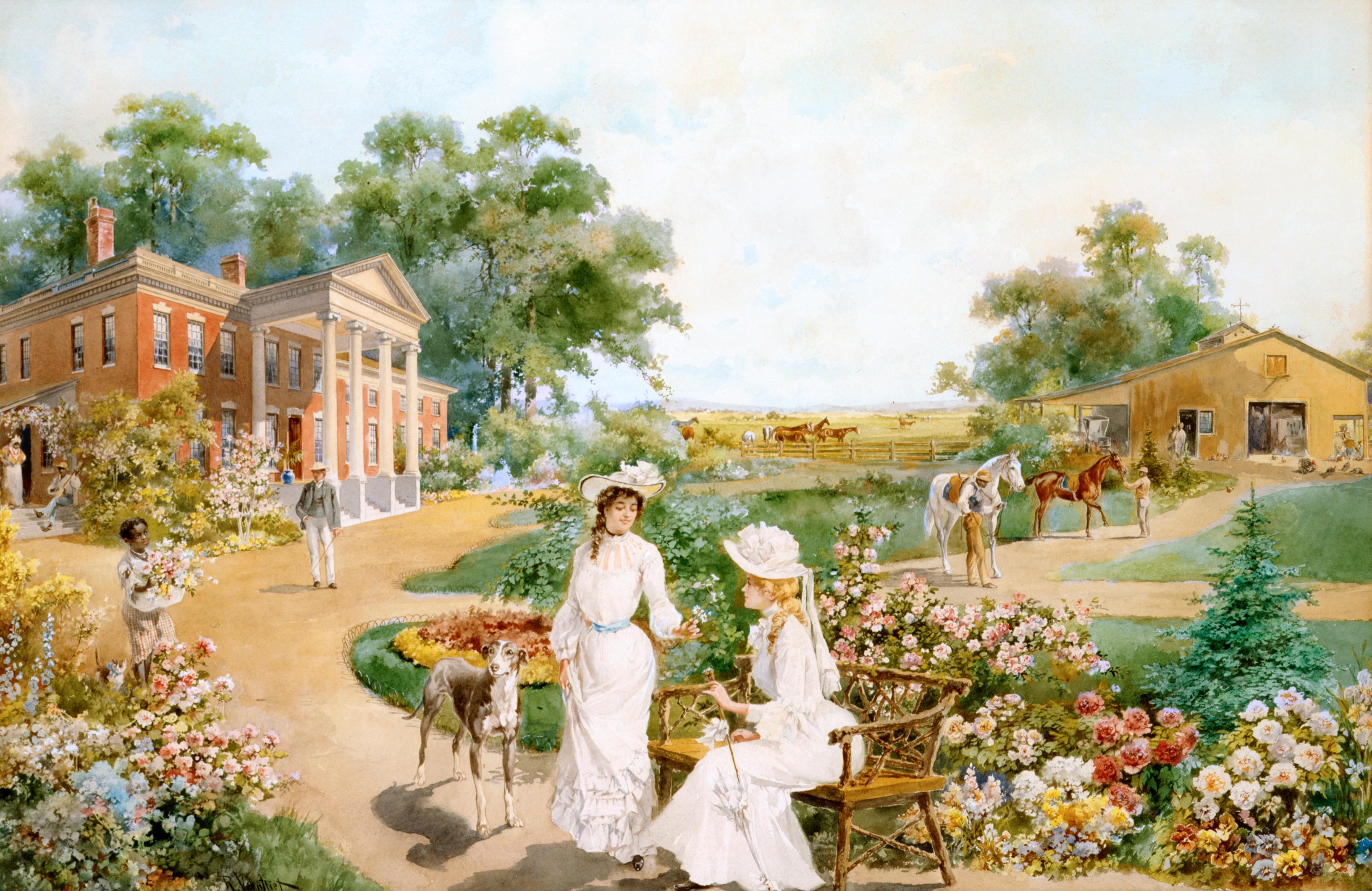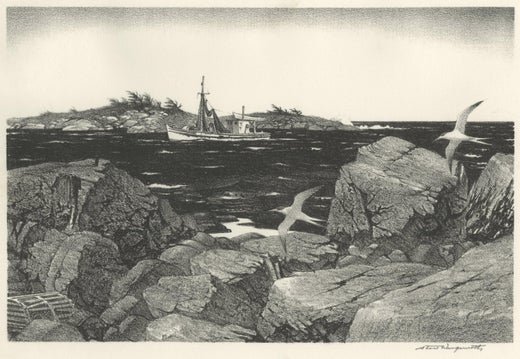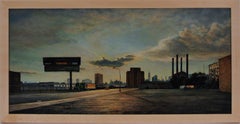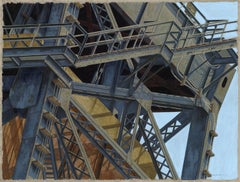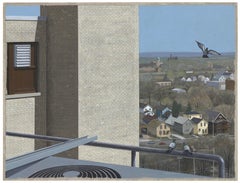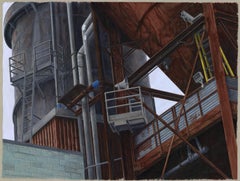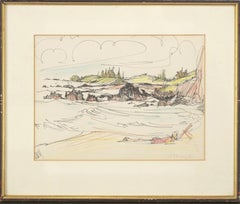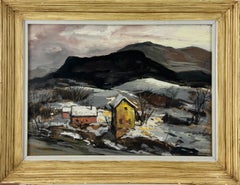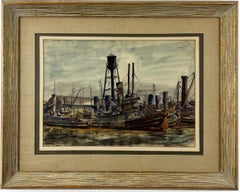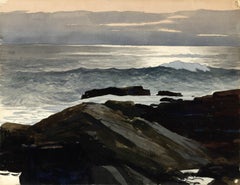
Shoreline.
View Similar Items
Want more images or videos?
Request additional images or videos from the seller
1 of 10
Stow WengenrothShoreline.circa 1965.
circa 1965.
Price:$1,000
About the Item
- Creator:Stow Wengenroth (1906 - 1978, American)
- Creation Year:circa 1965.
- Dimensions:Height: 15.25 in (38.74 cm)Width: 19.94 in (50.65 cm)
- Medium:
- Movement & Style:
- Period:
- Condition:Painted on watercolor paper. Stow Wengenroth used tacks in each of the corners to hold the paper down while it was being painted.
- Gallery Location:New York, NY
- Reference Number:Seller: #893251stDibs: LU33125083242
Stow Wengenroth
Born in Brooklyn in 1906, New York, Stow Wengenroth studied at the Art Students League of New York and Grand Central School of Art. He lived and worked for many years on Long Island and then moved to Rockport, Massachusetts. Wengenroth is renowned for his carefully wrought scenes of the New England seacoast like craggy rocks, lighthouses, boats and the sea. He died in 1978 in Rockport.
About the Seller
4.7
Recognized Seller
These prestigious sellers are industry leaders and represent the highest echelon for item quality and design.
Established in 1898
1stDibs seller since 2015
58 sales on 1stDibs
Typical response time: 22 hours
Associations
International Fine Print Dealers Association
Authenticity Guarantee
In the unlikely event there’s an issue with an item’s authenticity, contact us within 1 year for a full refund. DetailsMoney-Back Guarantee
If your item is not as described, is damaged in transit, or does not arrive, contact us within 7 days for a full refund. Details24-Hour Cancellation
You have a 24-hour grace period in which to reconsider your purchase, with no questions asked.Vetted Professional Sellers
Our world-class sellers must adhere to strict standards for service and quality, maintaining the integrity of our listings.Price-Match Guarantee
If you find that a seller listed the same item for a lower price elsewhere, we’ll match it.Trusted Global Delivery
Our best-in-class carrier network provides specialized shipping options worldwide, including custom delivery.More From This Seller
View AllLong Island City
By Frederick Mershimer
Located in New York, NY
Long Island City
Contemporary artist Frederick Mershimer created this oil painting on a wooden panel in 2005. The painting (wood panel) is 10.25 x 21.25 inches (26 x 54 cm). This ...
Category
21st Century and Contemporary American Realist Landscape Paintings
Materials
Oil, Wood Panel
Cle Series: Lift w/Ladders.
By Thomas R. Roese
Located in New York, NY
Inspired by the geometric landscape of his hometown Thomas Roese has created a photorealist series using acrylic, graphite, and colored pencil.
Since graduating from the Cleveland...
Category
21st Century and Contemporary Photorealist Landscape Paintings
Materials
Acrylic, Color Pencil, Graphite
725 CLE Series: Edge.
By Thomas R. Roese
Located in New York, NY
Inspired by the geometric landscape of his hometown Thomas Roese has created a photorealist series using acrylic, graphite and colored pencil.
Since graduating from the Cleveland ...
Category
21st Century and Contemporary Photorealist Landscape Paintings
Materials
Acrylic, Color Pencil, Graphite
725 CLE Series: Tank, Hopper w/Yellow Ladder.
By Thomas R. Roese
Located in New York, NY
Inspired by the geometric landscape of his hometown Thomas Roese has created a photorealist series using acrylic, graphite, and colored pencil.
Since graduating from the Cleveland...
Category
21st Century and Contemporary Photorealist Landscape Paintings
Materials
Acrylic, Color Pencil, Graphite
New York Skies.
By Emilio Sanchez
Located in New York, NY
Emilio Sanchez returned to the urban skyline time and again. His passion for the everchanging sky took hold during the 1980's working the ruled lines of the skyscraper in just enough...
Category
1980s Modern Landscape Paintings
Materials
India Ink, Oil, Watercolor
New York Sunset.
By Emilio Sanchez
Located in New York, NY
"New York Sunset" is a mixed media painting on paper (oil paint and waterbased paint) by artist Emilio Sanchez. It is painted to the paper edge.
Emilio Sanchez returned to the urba...
Category
1980s Modern Landscape Paintings
Materials
Oil, Watercolor
You May Also Like
Mid Century Modern Mixed Media Painting -- Day at the Beach
Located in Soquel, CA
Wonderful mid century mixed media coastal/figurative in loose/painterly style by Irmal Gertrude Attridge (American, 1894-1962), circa 1950. Signed lower right. Presented in vintage frame under glass (included as-is). Image size: 9"H x 12"W.
Irma Gertrude Attridge was born in Chicago and studied at Chouinard Art Institute in Los Angeles with Henry McFee and Oscar Van Young. Member of Calif. AC; AEA; Cal. WC. Soc.; Women Painters...
Category
1950s American Realist Landscape Paintings
Materials
Ink, Watercolor, Color Pencil, Laid Paper
Dwellings on the River -Realist American Winter Landscape
Located in Marco Island, FL
American realist landscape by Cleveland artist Carl Gaertner. This snowy scene, painted in 1943, was typical of the traditional American realist landscapes of the time.
Carl Ga...
Category
1940s American Realist Landscape Paintings
Materials
Gouache, Board
Tugboats in the Harbor. American Landscape -1930s Industrial Harbor Scene
By Reginald Marsh
Located in Marco Island, FL
A fine 1938 watercolor done of Tugboats in the Harbor by Reginald Marsh. The painting depicts the crush of boats at the shoreline during the later part of the American Great Depress...
Category
1930s American Realist Landscape Paintings
Materials
Watercolor, Archival Paper
"Lobstermen in Gloucester, Mass." Lionel Reiss WPA Social Realism Fishermen
By Lionel S. Reiss
Located in New York, NY
Lionel S. Reiss (1894 - 1988)
Lobstermen in Gloucester, Massachusetts, circa 1943
Watercolor on paper
Sight 17 1/2 x 23 inches
Signed lower left
Provenance:
Private Collection, Las Vegas, Nevada
In describing his own style, Lionel Reiss wrote, “By nature, inclination, and training, I have long since recognized the fact that...I belong to the category of those who can only gladly affirm the reality of the world I live in.” Reiss’s subject matter was wide-ranging, including gritty New York scenes, landscapes of bucolic Bucks County, Pennsylvania, and seascapes around Gloucester, Massachusetts. However, it was as a painter of Jewish life—both in Israel and in Europe before World War II—that Reiss excelled. I.B. Singer, the Nobel Prize winner for Literature, noted that Reiss was “essentially an artist of the nineteenth century, and because of this he had the power and the courage to tell visually the story of a people.”
Although Reiss was born in Jaroslaw, Poland, his family immigrated to the United States in 1898 when he was four years old. Reiss's family settled on New York City’s Lower East Side and he lived in the city for most of his life. Reiss attended the Art Students League and then worked as a commercial artist for newspapers and publishers. As art director for Metro-Goldwyn-Mayer, he supposedly created the studio’s famous lion logo.
After World War I, Reiss became fascinated with Jewish life in the ‘Old World.’ In 1921 he left his advertising work and spent the next ten years traveling in Europe, the Middle East, and North Africa. Like noted Jewish photographers Alter Kacyzne and Roman Vishniac, Reiss depicted Jewish life in Poland prior to World War II. He later wrote, “My trip encompassed three main objectives: to make ethnic studies of Jewish types wherever I traveled; to paint and draw Jewish life, as I saw it and felt it, in all aspects; and to round out my work in Israel.”
In Europe, Reiss recorded quotidian scenes in a variety of media and different settings such as Paris, Amsterdam, the Venice ghetto, the Jewish cemetery in Prague, and an array of shops, synagogues, streets, and marketplaces in the Jewish quarters of Warsaw, Lodz, Krakow, Lublin, Vilna, Ternopil, and Kovno. He paid great attention to details of dress, hair, and facial features, and his work became noted for its descriptive quality.
A selection of Reiss’s portraits appeared in 1938 in his book My Models Were Jews. In this book, published on the eve of the Holocaust, Reiss argued that there was “no such thing as a ‘Jewish race’.” Instead, he claimed that the Jewish people were a cultural group with a great deal of diversity within and between Jewish communities around the world. Franz Boas...
Category
1940s American Realist Landscape Paintings
Materials
Paper, Watercolor
Circus Wagons
By Millard Sheets
Located in Los Angeles, CA
This watercolor is part of our exhibition America Coast to Coast: Artists of the 1930s
Circus Wagons, 1927, watercolor on paper, signed and dated lower left, 10 x19 ¾ inches (sight), provenance includes Stary-Sheets Art Gallery (Gualala, CA); J. Ralph & Louis Stone Foundation; presented in a newer metal frame behind glazing
About the Painting
Millard Sheets was only twenty years old and in his third year of studies at the Chouinard Art Institute when he painted Circus Wagons. Despite his youth, Sheets was already an accomplished artist who had publicly exhibited his work and won prestigious prizes. Within several years, he would have his first solo exhibition at one of Los Angeles’ premiere galleries and become a painting instructor at his alma mater. In Circus Wagons we already see Sheets deft handling of the watercolor medium and his interest in the California Scene. In this case, Sheets captures a back lot view of a traveling circus, a subject he sometimes returned to, including in a color screen print in the collection of the National Gallery. Sheets made a career by painting what he knew and observed firsthand. This approach allowed Sheets to capture with authenticity the details of each narrative. Even with a narrowly limited palette and an economy of brushstrokes, Sheets effectively depicts the southern California scene with its strong and mysterious shadows, as well as the workers and circus animals. Seen through the hindsight of his six-decade long career, Circus Wagons offers a fascinating insight into the early development of California Scene painting which would by the mid-1930s become the best recognized style on the West Coast.
About the Artist
Millard Sheets was the dean of California watercolorists. His list of accomplishments is so extensive that his entry in Who was Who in American Art is over forty lines. Born in Pomona, California, Sheets became a painter at an early age, winning a prize at the Los Angeles County Fair in 1918. By the mid to late-1920s, Sheets became a regular at art exhibitions in the western part of the United States, winning several additional prizes before he reached the age of twenty-five. Sheets studied at the prestigious Chouinard Art Institute from 1925 through 1929 with Frank Tolles Chamberlin and Clarence Hinkle and had his first solo show with Los Angeles’ Dalzell Hatfield Gallery in 1929. During the 1930s, Sheets was invited to exhibit at almost every major American Museum and in many ways, his work came to represent the California watercolor school...
Category
1920s American Realist Figurative Paintings
Materials
Watercolor
Pulp Magazine Marine Combat Scene Shoot Out in Blue Noir
Located in Miami, FL
What makes this work important?
It's not that it's a commissioned artwork for a men's 60s pulp adventure magazine depicting the instant a soldier is shot. The big point of the painting is how brilliantly the formal elements are thought out, designed, and executed. John McDermott tells a story using a complex figural composition in an unexpected wide-angle vision. The work is as abstract as it is representation. His use of light is significant because it creates a high-contrast two-color style that bears the mark of its creator. This is a work done by a master artist/illustrator without peers compared to artists living today. If the contemporary art world gave awards for draftsmanship, painting technique, and graphic design .... John McDermott would win the highest accolades.
Initialed lower left - unframed
John McDermott (August 30, 1919 – April 20, 1977), also known under the pen names J.M. Ryan and Mariner, was an American illustrator and author noted for action and adventure illustrations.[1] McDermott worked as an in-between and effects animator for Walt Disney Studios and as a US Marine combat artist,before establishing himself as a cover illustrator for 1950s paperbacks and pulp magazines such as Argosy, American Weekly, and Outdoor Life. Under his J.M. Ryan pen name, he wrote the novels The Rat Factory (1971), a derogatory satire of Walt Disney and the Disney studio; Brooks Wilson Ltd (1967), on which the 1970 film Loving was based; and Mother's Day (1969) about Ma Barker. Under his own name, he novelized director-writer Bo Widerberg's screenplay for the 1971 film Joe Hill, which would be his final published book.
Early life
John Richard McDermott was born 30 August 1919 in Pueblo, Colorado, the younger of two sons of Henry McDermott, an oil broker. McDermott was a young child when his father committed suicide.[4] The family eventually moved to Los Angeles where McDermott's mother, Hazel, worked in a beauty parlor. He graduated from Hollywood High School in 1936. Although he had had no formal art education, he took a job as an artist at Walt Disney Animation Studios.
Career
Disney
At Disney, McDermott worked as an in-betweener and effects animator on Brave Little Tailor, Pinocchio, The Reluctant Dragon and Fantasia. His experiences while working at Disney, particularly during the time of the 1941 Disney animators' strike, would later become the basis for his 1969 satirical novel The Rat Factory. McDermott left Disney to fight with US forces during World War II.
US Marines
McDermott World War II sketch titled "Buddy is Wounded"
On September 29, 1942, McDermott enlisted with the US Marine Corps. He served as a "pistol and palette" combat artist assigned to the map-making section. As a sergeant with the III Amphibious Corps, McDermott was involved in battles in the South Pacific theater of war, documenting the Guam, Okinawa and the Guadalcanal Campaigns. McDermott considered his wartime years to be his art education.
"In the Marines, as a combat artist, I traveled with the troops and for three years got all the drawing opportunity anyone could want. My work changed enormously during this time and I’m sure it was due to constant drawing, every single day, from life, just putting down what I saw around me. In a few instances it was a dangerous kind of scholarship."
According to the Marine Corps history journal Fortitudine, McDermott was so prolific that his contemporary style pen-and-ink sketches became easily recognizable to both Marines, from published work in Leatherneck Magazine, and civilians, from glossy copies supplied by the Marine Corps to the nation's press.His wartime art appears in World War II history books and is displayed at the Pentagon and the National Museum of the Marine Corps.
Illustration
Following the end of World War II, McDermott moved from California to New York City to work as a freelance illustrator. McDermott made his reputation drawing modern action, war and adventure scenes. His work adorned the covers and inside story pages of popular pulp magazines of the 1950s such as Argosy, Adventure, Blue Book, Outdoor Life and American Weekly.
McDermott's illustrations appeared on numerous covers of 1950s paperback novels published by Dell, Fawcett Gold Medal, Bantam Mystery and others. His action graphics were geared toward thriller and detective genres, such as Donald Hamilton's Matt Helm books Murderers' Row and The Betrayers. He also created covers for science fiction comic titles such as Voyage to the Deep[citation needed] and horror-themed paperbacks such as the classic 1955 science fiction novel The Body Snatchers...
Category
1960s American Realist Figurative Paintings
Materials
Gouache, Illustration Board
